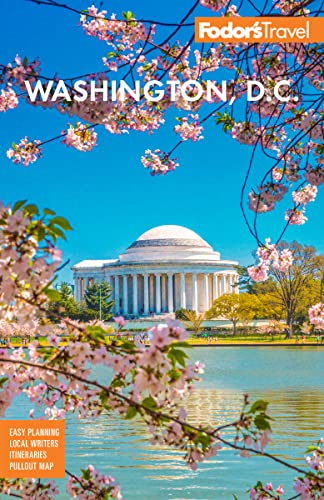Dupont Circle Walk
Two hours should be enough to walk the main sights here, longer if you want to linger in some of the neighborhood's fascinating small museums and enticing cafés.
Take the Metro to the dramatic Dupont Circle Q Street exit and find yourself in the heart of D.C.'s most eclectic neighborhood. If you arrive on a Sunday morning, you will emerge into the year-round Fresh Farm Market at the corner of Q and 20th streets. The large island in the middle of the traffic circle a few paces down Connecticut Avenue is a lively urban park, vibrant with skateboarders, chess players, and street performers, all congregating around a marble fountain created by Daniel Chester French. On sunny days the surrounding benches are pleasant spots for people-watching, newspaper reading, or relaxing with a cup of coffee and a snack. Also nearby is the bookstore Kramerbooks & Afterwords, which has a popular café, open daily and throughout the night on Friday and Saturday.
Northwest of Dupont Circle
Head up the main north–south artery of Connecticut Avenue, lined with shops, restaurants, and cafés that are busy day and night. Turning left onto R Street you'll pass No. 2131, an understated white-painted town house, home to FDR and Eleanor Roosevelt between 1916 and 1920. Detour a block south on 21st Street to find the Phillips Collection, founded as the first permanent museum of modern art in the country, with a collection including works by Renoir, Degas, van Gogh, Picasso, Cassatt, Klee, and Matisse.
Along R Street lies a variety of art galleries. Nestled among them is the nonprofit Fondo Del Sol Visual Arts Center, devoted to the cultural heritage of Latin America and the Caribbean. Detour east on R Street for the National Museum of American Jewish Military History, which displays weapons, uniforms, medals, recruitment posters, and other military memorabilia related to American Jews serving in the U.S. military. This neighborhood also includes an Italianate mansion built in 1901 at 15 Dupont Circle. President Calvin Coolidge and his wife lived here in 1927 while the White House was undergoing a renovation. Coolidge welcomed many dignitaries as houseguests there, including Charles Lindbergh after his transatlantic flight.
At the west end of R Street, Sheridan Circle and Massachusetts Avenue are home to a cluster of embassies in striking villas. North on Massachusetts Avenue, S Street edges into the Kalorama district. The Woodrow Wilson House shows the former president's home pretty much as he left it. On display are his personal possessions, such as hats and canes, and many gifts from foreign dignitaries.
Just south of Sheridan Circle the Bison Bridge is guarded by four bronze statues of the shaggy mammals. Nearby, the Anderson House was bequeathed by Larz and Isabel Anderson to the Society of the Cincinnati, an exclusive club of the descendants of Revolutionary War officers. Next door, the Walsh-McLean House was once home to the last private owner of the Hope Diamond (now in the National Museum of Natural History). Head back to Connecticut Avenue for tea, lunch, or a snack before continuing on.
Southeast of Dupont Circle
Past Dupont Circle, heading down Massachusetts Avenue toward Scott Circle, you will pass the Brookings Institution and the Johns Hopkins University D.C. campus buildings. The Heurich House Museum, once known as the Brewmaster's Castle, was the home of a German-born beer magnate and is nearby on New Hampshire Avenue. Scott Circle is decorated with statues of General Winfield Scott, Daniel Webster, and S. C. F. Hahnemann. If you walk to the south side of the circle and look down 16th Street, a familiar view of the White House awaits, but six blocks away. Nearby, down 17th Street, the National Geographic Society brings its magazines to life with interactive exhibits, photo galleries, and live shows.
A few sights lie clustered on or near M Street south of Scott Circle, including two noteworthy religious institutions: the Metropolitan African Methodist Episcopal Church, one of the most influential African American churches in the city, and the Renaissance-style St. Matthew's Cathedral, the seat of Washington's Roman Catholic diocese, and where President Kennedy's funeral Mass was held.
Logan Circle
The epicenter of this neighborhood, sometimes called MidCity, is at the intersection of P and 14th streets. Bars and restaurants buzz by day and spill out onto the sidewalks at night. In the early 2000s, gentrification took hold and brought to life a neighborhood damaged by the upheavals of the 1960s. Though revitalized, visitors should take a moment to notice the layers of history.
Logan Circle itself can be found to the east along P Street, a circle of brooding redbrick Victorian mansions built between 1875 and 1900, and the surrounding streets where many prominent African Americans once lived. One block south of the circle on Vermont Avenue, the Mary McLeod Bethune Council House features exhibits on the achievements of African American women. Around the corner on 14th, you'll come across the highly regarded Studio Theater, a number of contemporary art galleries, more boutiques, and music venues—all part of 14th Street's thriving arts scene that continues to U Street.




